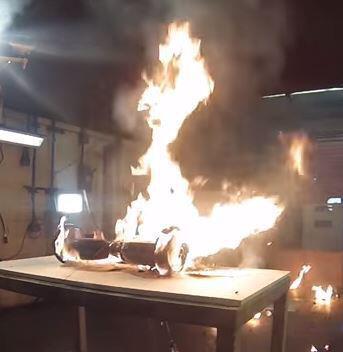Everyone has probably seen some coverage of hoverboard fire incidents on the news. Many of them have required fire service response. In order to better understand these failures UL’s Research Team demonstrated the fire dynamics that result from a hoverboard that undergoes thermal runaway. FSRI wants to increase the knowledge of the fire service by showing what is happening prior to their arrival to these incidents. Fire investigators should also note the potential for multiple points of ignition as flaming components are projected away from the hoverboard.
The demonstration shown in this video illustrates what happens when a Lithium Ion battery goes into thermal runaway – independent of what motivated it to do so (overcharging, poor quality cells etc.). The technique of heating the cells to induce thermal runaway was chosen in lieu of two other techniques which have been used to drive a thermal runaway:
- mechanical stress – such as a blunt nail.
- modifying the internal construction of the cell to compromise the insulator within the device.
- External heating of the battery cell was chosen because of a high degree of confidence that the cell would go into thermal runaway
New UL 2272 provides framework to evaluate, test, and certify self-balancing scooters On February 2nd UL announced that the company is now accepting product submittals of self-balancing scooters, also known as hoverboards, for construction evaluation, testing, and/or UL certification. UL will now be able to test and certify these devices using UL 2272, which covers the electric drive train including the rechargeable battery and charger system combination for use in self-balancing scooters.“UL has been evaluating, testing, and certifying battery cells, modules, and packs as well as related battery chargers and power supplies as individual components for many years,” said Jeff Smidt, vice president and general manager for UL’s Energy and Power Technologies division. “With UL 2272, our expert science, research, and engineering teams have now developed the appropriate requirements and methodology to confidently evaluate and test the entire self-balancing scooter for electrical and fire-hazard safety as a system. As recent news has shown us, there is a strong need for this type of service, and today we are pleased to offer our testing and certification services to manufacturers and distributors.”
Retailers and manufacturers interested in submitting hoverboards for product testing and/or UL certification are welcome to submit their request via the form at http://contact.ul.com/contact-ul-energy, or emailRenewableEnergyQuote@ul.com. Visit www.ul.com/hoverboards for consumer safety tips, information about UL’s work to combat counterfeit UL marks, and facts about UL’s involvement with hoverboards. Visit www.ul.com/batteries for more information about the battery & energy storage technology services UL offers for a wide range of motive & stationary applications.

